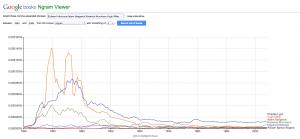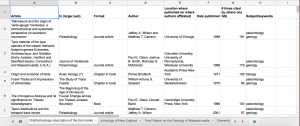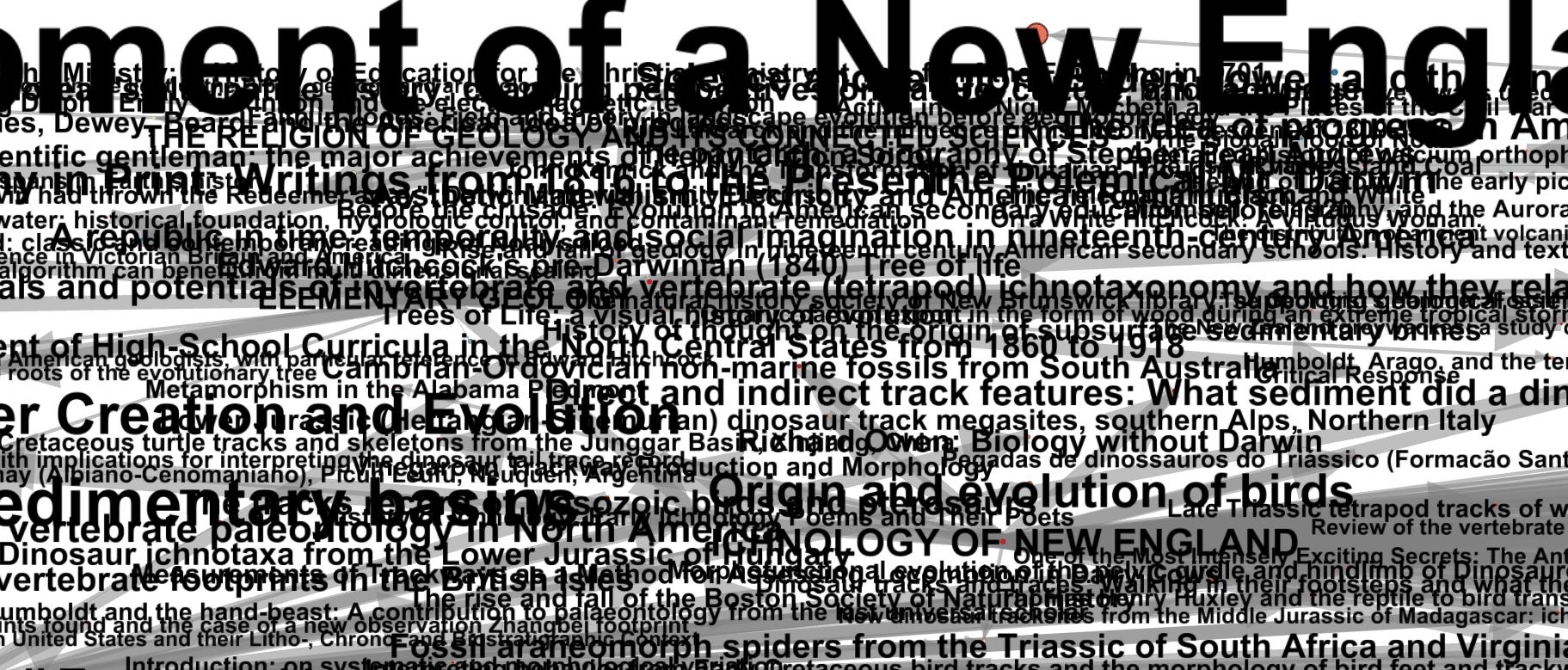The Process
From the beginning of this project, the rest of the team and I had been interested in the question of contextualizing Edward Hitchcock’s legacy. As students at Amherst College, where Hitchcock is best known as professor and president, we are affected by a kind of myopia in the way we relate to the college’s history and judge who should be regarded as worthy of remembering. Coming to Amherst, we are told—unconsciously, if not explicitly, by our history books, administration, and the names of our buildings—that Edward Hitchcock is someone important, someone we should care about. In the comfort of the Amherst “bubble,” this is easy to take for granted and raises the question: what does Edward Hitchcock look like from the outside?
In J.P. Lesley’s 1866 brief memoir of Edward Hitchcock for the National Academy of Sciences, Lesley describes Hitchcock in high terms for his geological achievements, placing him at and above the rank of other renowned geologists of the era:
“Sedgwick and the Cambrians, Murchison and the Silurians, Hugh Miller and the Devonians, Rogers and the Appalachians, Lyell and the Tertiaries, are not more household terms in the history of our science, than is ‘Hitchcock and the New Red Sandstone’ of the Connecticut River Valley.”
However, a quick Google Ngrams search could suggest otherwise, but this  too is a myopic view, formed by the limits of the Google Books corpus and the simplicity of the search function.
too is a myopic view, formed by the limits of the Google Books corpus and the simplicity of the search function.
For a more accurate examination of Edward Hitchcock’s intellectual legacy, I turned to a more targeted search for instances when his name arises in text, namely, when he is referenced as a source in the body or bibliography of other scholarly works. I was inspired by a similar project, a Cocitation Network Graph produced as part of the Signs@40 project that mapped out the network of all sources who the contributors to the journal had cited over the past 40 years.
Around the same time, we interns began experimenting with Gephi, a popular networking graphing software, and I realized there was potential to create a similar network for Edward Hitchcock’s writing. Given the difference in nature and scope between Signs@40 and our own project, I had to come up with a new set of criteria for the data to extract and model that would give us the best sense of Hitchcock’s influence.
There are innumerable online databases where one can find scholarly articles and read their citation data. For my sanity, I limited myself to Google Scholar, believing that it would be the widest net for collecting and compiling records of when and where Edward Hitchcock’s writing had been cited over the years. Because Hitchcock was so prolific, I also limited my search to citations of five specific works: his “greatest hits,” if you will. These five were not necessarily the most cited of his works, but they all came from the top ten, and represented the cornerstones of his intellectual interests: ichnology, geology, and religion.
 The data collection process was tedious but fascinating. As I went through the Google Scholar search results, I collected a set of specific data from each case where Hitchcock was cited. This information included name of publication, author, place published, date published, topic of piece, and number of times it in turn had been cited by other texts (according to Google Scholar). I was surprised to see the diversity of data within each of these criteria; not only was Hitchcock still being cited, he was being cited as recently as 2015 by geologists in places as wide-ranging as Sweden and China.
The data collection process was tedious but fascinating. As I went through the Google Scholar search results, I collected a set of specific data from each case where Hitchcock was cited. This information included name of publication, author, place published, date published, topic of piece, and number of times it in turn had been cited by other texts (according to Google Scholar). I was surprised to see the diversity of data within each of these criteria; not only was Hitchcock still being cited, he was being cited as recently as 2015 by geologists in places as wide-ranging as Sweden and China.
I was eager to take my raw data and throw it into some mapping software, which I assumed would immediately and easily cough up some visuals ripe for interpretation. Oh, what I naive child I was, just a week ago. Navigating and formatting data in the visualization software was easily the most difficult part of the project. As someone who is fairly new to data modeling and digital tools, the platforms and terminology that the software operated on were largely foreign to me.
I had originally proposed mapping the citation data in Gephi, which provided the product closest to the Signs@40 model I had so loved. After a bewildering first run with Gephi, I was confused enough to back away and test out another potential platform for data viz, this one called Tableau. Tableau was much more intuitive to operate and provided more versatile options for approaches to visualizing data, but after playing around a bit, I realized I didn’t want more versatile options. I wanted to build a network visualization, and the complexities of Gephi made it a tool better equipped to do that than friendly Tableau.
So I returned to Gephi, chagrined but determined to master its ways. With a lot of trial and error, youtube tutorials, and time, I managed to fit my data into the appropriate form so that Gephi would not only take it, but I could manipulate it as well. Unfortunately, I lost a lot of time during my Gephi learning phase, and didn’t have the opportunity to make the final network as comprehensive as I had dreamed of in the beginning.
Gephi also was more limited in tools and functionality than I had hoped, and I likely would not have been able to visualize all of the data that I’d originally hoped to. While I was unable to map geographic location (which had been very important to me in the beginning), I still feel that the final graph contains much of the other data I’d collected that was central to measuring Hitchcock’s influence. Namely, this data includes when the citing publication was authored, its subject, and how many times it itself has been cited.
The data I collected in those categories was surprisingly telling, both in magnitude and diversity. The network visualizations are able to speak for themselves, on that point. Edward Hitchcock, while not quite on par with the fame of his contemporary Darwin (to whom he sent a copy of his books) or fellow Amherstian Emily Dickinson (who studied under the curriculum he designed at Amherst Academy), still lives on, in his words and ideas. From Swedish doctoral theses in agricultural science to French scholars of American literary history, Hitchcock’s name, authority, and legacy continues ever onward, evolving and changing just as the land of New England he once walked.
